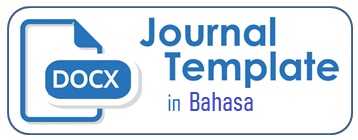Dampak Sosial Ekonomi Bencana Banjir dan Pemetaannya Berbasis Sistem Informasi Geografis (SIG)
Abstract
The purpose of this study was to determine the distribution of flood locations in the Rokan Hulu regional administrative area and to determine the socio-economic impact of flooded households by modeling the distribution of flood locations based on Geographic Information Systems (GIS). The population is residential residents of Rokan Hulu Regency and floodplain sampling points located in the floodplains. The possibility of a flood disaster in Rokan Hulu Regency is very vulnerable and is divided into 16 districts. The research data was evaluated using point analysis method. There are two types of spatial mapping used, namely spatial mapping and spatial overlay. Spatial mapping is a description of conditions on a map, while spatial overlay is an analysis of several maps to create a new map. This mapping produces a flood hazard map, as well as a combination of point analysis and coverage analysis.
References
Adam, S. S., Rindarjono, M. G., & Karyanto, P. (2019). Sistem informasi geografi untuk zona kerentanan kebakaran lahan dan hutan di Kecamatan Malifut, Halmahera Utara. Jurnal Teknologi Informasi dan Ilmu Komputer, 6(5), 559-566. http://dx.doi.org/10.25126/jtiik.2019651674.
Allaire, M. (2018). Socio-economic impacts of flooding: A review of the empirical literature. Water Security, 3(May), 18-26. https://doi.org/10.1016/j.wasec.2018.09.002.
Anwar, Y., Setyasih, I., Ningrum, M. V., & Jedo, A. (2022). Dampak banjir terhadap ekonomi masyarakat di Kecamatan Samarinda Utara, Kota Samarinda. Jurnal Pendidikan Ekonomi, 9(1), 40-48. http://dx.doi.org/10.20527/jpg.v9i1.12457.
Bleemer, Z., & Van der Klaauw, W. (2017). Disaster (over-) insurance: The long-term financial and socioeconomic consequences of Hurricane Katrina. Federal Reserve Bank of New York Staff Reports, 807(February). https://www.newyorkfed.org/research/staff_reports/sr807.
Bubeck, P., Otto, A., & Weichselgartner, J. (2017). Societal impacts of flood hazards. Oxford Research Encyclopedia of Natural Hazard Science, Oxford University Press. http://dx.doi.org/10.1093/acrefore/9780199389407.013.281.
Cronin, S. J., Gaylord, D. R., Charley, D., Alloway, B. V., Wallez, S., & Esau, J. W. (2004). Participatory methods of incorporating scientific with traditional knowledge for volcanic hazard management on Ambae Island, Vanuatu. Bull Volcanol, 66, 652–668. https://doi.org/10.1007/s00445-004-0347-9.
Darmawan, K., Hani’ah, & Suprayogi, A. (2017). Analisis tingkat kerawanan banjir di Kabupaten Sampang menggunakan metode overlay dengan scoring berbasis sistem informasi geografis. Jurnal Geodasi Undip, 6(1), 31-40. https://doi.org/10.14710/jgundip.2017.15024.
Falihin, D., Rusdi, Balkis, S., Ramli, M., & Amelia, R. (2021). Persepsi masyarakat terhadap bencana banjir di Kabupaten Soppeng. Seminar Nasional Hasil Penelitian 2021 “Penguatan Riset, Inovasi, dan Kreativitas Peneliti di Era Pandemi Covid-19”: Prosiding Edisi 3 , 527-535. https://ojs.unm.ac.id/semnaslemlit/article/view/25289.
Fatimah, Mukid, M. A., & Rusgiyono, A. (2017). Analisis credit scoring menggunakan metode bagging K-nearest neighbor. Jurnal Gaussian, 6(1), 161-270. https://doi.org/10.14710/j.gauss.6.1.161-170.
Findayani, A. (2015). Kesiapsiagaan masyarakat dalam penanggulangan banjir di Kota Semarang. Jurnal Geografi, 12(1), 102-114. https://journal.unnes.ac.id/nju/index.php/JG/article/view/8019/5561.
Greene, S. K., Wilson, E. L., Konty, K. J., & Fine, A. D. (2013). Assessment of reportable disease incidence after hurricane sandy, New York City, 2012. Disaster medicine and public health preparedness, 7(5), 513-521. https://doi.org/10.1017/dmp.2013.98.
Hanifah, M. H. (2022). Analisis dampak bencana banjir Rob terhadap perubahan struktur sosial dan ekonomi masyarakat pesisir (Studi kasus Kecamatan Sayung, Kabupaten Demak). Skripsi. Universitas Muhammadiyah Surakarta. http://eprints.ums.ac.id/100785/.
Hapsoro, A. W., & Buchori, I. (2015). Kajian kerentanan sosial dan ekonomi melawan bencana banjir (Studi kasus: Wilayah pesisir Kota Pekalongan). Jurnal Teknik PWK, 4(2), 542-553. https://doi.org/10.14710/tpwk.2015.9814.
Ismoyojati, G., Sujono, J., & Jayadi, R. (2019). Studi pengaruh perubahan tataguna lahan terhadap karakteristik banjir Kota Bima. Jurnal Geografi Lingkungan, 2(2), 14-27. http://dx.doi.org/10.7454/jglitrop.v2i2.46.
Janin, N. H., & Risfaisal. (2021). Perubahan sosial ekonomi masyarakat petani pasca banjir bandang di Desa Meli Kecamatan Baebunta Kabupaten Luwu Utara. Aksiologi, 2(1), 32-39. https://doi.org/10.47134/aksiologi.v2i1.65.
Kasih, B. T. H., Juaeni, I., & Harijono, S. W. B. (2007). Proses meteorologis bencana banjir di Indonesia. Jurnal Meteorologi dan Geofisika, 8(2), 1-13. https://dx.doi.org/10.31172/jmg.v8i2.12.
Kodoatie, R. J., & Roestam, S. (2010). Tata ruang air. Andi.
Majid,. A., Razman, M. R., Zakaria, S. Z., Ahmed, M. F., & Zulkafli, S. A. (2021). Flood disaster in Malaysia: Approach review, causes and application of geographic information system (GIS) for mapping of flood risk area. Ecology, Environment and Conservation Paper, 27(Supplement Issue), 1-8. http://www.envirobiotechjournals.com/article_abstract.php?aid=11329&iid=329&jid=3.
Matondang, J. P., Kahar, S., & Sasmito, B (2013). Analisis zonasi daerah rentan banjir dengan pemanfaatan sistem informasi geografis (Studi kasus: Kota Kendal dan sekitarnya). Jurnal Geodesi Undip (JGU), 2(2), 103-113. https://doi.org/10.14710/jgundip.2013.2442.
Maulida, D. (2013). Estimasi kerugian ekonomi akibat banjir sungai pesanggrahan di pemukiman Kedoya Selatan Jakarta Barat. Thesis. Institute Pertanian Bogor. https://repository.ipb.ac.id/handle/123456789/67035.
McClymont, K., Morrison, D., Beevers, L., & Carmen, E. (2020). Flood resilience: A systematic review. Journal of Environmental Planning and Management, 63(7), 1151-1176. https://doi.org/10.1080/09640568.2019.1641474.
Munawar, H. S., Khan, S. I., Anum, N., Qadir, Z., Kouzani, A. Z., & Parvez Mahmud, M. A. (2021). Post-flood risk management and resilience building practices: A case study. Applied Sciences, 11(11), 4823. https://doi.org/10.3390/app11114823.
Nabangchang, O., Allaire, M., Leangcharoen, P., Jarungrattanapong, R., & Whittington, D. (2015). Economic costs incurred by households in the 2011 greater Bangkok flood. Water Resources Research, 51(1), 58-77. https://doi.org/10.1002/2014WR015982.
Novita, R., Kadir, H., & Eriyanti. (2014). Nilai kerugian masyarakat akibat bandir di Kecamatan Pujud Kabupaten Rokan Hilir. Jurnal JOM FEKON, 1(2), 1-18. https://jom.unri.ac.id/index.php/JOMFEKON/article/download/4754/4637.
Nurdin, F., & Djuniati, S. (2018). Analisis kawasan rawan banjir Sungai Rokan di Kabuoaten Rokan Hulu dan Kabupaten Rokan Hilir. Prosiding, Seminar Nasional Pelestarian Lingkungan. https://repository.unri.ac.id/handle/123456789/9503.
Nurdiyanto. (2016). Analisis hujan dan tata guna lahan terhadap limpasan permukaan di sub DAS Pekalen Kabupaten Porbolinggo. Jurnal Teknik Pengairan: Journal of Water Resources Engineering, 7(1), 83–94. https://jurnalpengairan.ub.ac.id/index.php/jtp/article/view/249.
Ortiz, D. (2020). Geographic information systems (GIS) in humanitarian assistance: A meta-analysis. Pathways: A Journal of Humanistic and Social Inquiry, 1(2), 1-13. https://repository.upenn.edu/pathways_journal/vol1/iss2/4/.
Otomofa, J., Okafor, B. N., & Obienusi, E. A. (2015). Evaluation of the impacts of flooding on socio-economic activities in Oleh, Isoko South local government area. Journal of Environment and Earth Science, 5(18), 155-171. https://www.iiste.org/Journals/index.php/JEES/article/view/26031.
Rentschler, J. E. (2013). Why resilience matters - The poverty impacts of disasters. Policy Research Working Paper, 6699. World Bank. https://doi.org/10.1596/1813-9450-6699.
Rosyidie, A. (2013). Banjir: Fakta dan dampaknya, serta pengaruh dari perubahan guna lahan. Jurnal Perencanaan Wilayah dan Kota, 24(3), 241-249. https://doi.org/10.5614/jpwk.2013.24.3.1.
Santri, S., Apriyanto, E., & Utama, S. P. (2020). Dampak sosial ekonomi dan estimasi kerugian ekonomi akibat banjir di Kelurahan Rawa Makmur Kota Bengkulu. Naturalis, 9(2), 77-84. https://doi.org/10.31186/naturalis.9.2.13509.
Souissi, D., Zouhri, L., Hammami, S., Msaddek, M. H., Zghibi, A., & Dlala, M. (2019). GIS-based MCDM - AHP modeling for flood susceptibility mapping of arid areas, Southeastern Tunisia. Geocarto International, 35(9), 1-56. https://doi.org/10.1080/10106049.2019.1566405.
Sugiyono. (2013). Metode penelitian kuantitatif, kualitatif dan R & D. Alfabeta.
Suhardiman. (2012). Zonasi tingkat kerawanan banjir dengan sistem informasi geografis (SIG) pada sub DAS Walanae Hilir. Thesis. Universitas Hasanuddin. http://repository.unhas.ac.id/handle/123456789/2040.
Suherman, H., & Firmansyah, A. (2017). Analisis pengaruh perubahan tataguna lahan terhadap debit banjir di wilayah hilir aliran Kali Angke. Konstruksia, 8(2), 79-95. https://doi.org/10.24853/jk.8.2.79-95.
Umar, Y. (2023). Komunikasi budaya gotong royong masyarakat Gorontalo terhadap dampak banjir di masa pandemi Covid-19. Al-Qaul: Jurnal Dakwah dan Komunikasi, 2(1), 1-13. https://doi.org/10.33511/alqaul.v2n1.1-13.
Utama, G. S. (2022). Penentuan tingkat kerawanan bencana banjir di Kota Malang menggunakan sistem informasi geografis (SIG). Publikasi Ilmiah, 1-13. https://www.researchgate.net/publication/357699800_Penentuan_Tingkat_Kerawanan_Bencana_Banjir_Di_Kota_Malang_Menggunakan_Sistem_Informasi_Geografis_SIG.
Yunida, R., Kumalawati, R., & Arisanty, D. (2017). Dampak bencana banjir terhadap kondisi sosial ekonomi masyarakat di Kecamatan Batu Benawa Kabupaten Hulu Sungai Tengah Kalimantan Selatan. JPG (Jurnal Pendidikan Geografi), 4(4), 42-52. http://dx.doi.org/10.20527/jpg.v4i4.3812.
Zevenbergen, C., Gersonius, B., & Radhakrishan, M. (2020). Flood resilience. Philosophical Transactions of the Royal Society A, 378(20190212), 1-17. https://doi.org/10.1098/rsta.2019.0212.
Zuheldi, Z., Yulius, N., & Mizwar, Z. (2021). Kajian faktor-faktor penyebab dan dampak banjir di Kota Bukit Tinggi. Ensiklopedia of Journal, 3(3), 253-258. https://doi.org/10.33559/eoj.v3i3.785.
Copyright (c) 2023 Tri Kurniawati Ratnaningsih, Heffi Christya Rahayu, Etty Puji Lestari, Sultan Sultan, Ahmad Fathoni

This work is licensed under a Creative Commons Attribution-ShareAlike 4.0 International License.


















